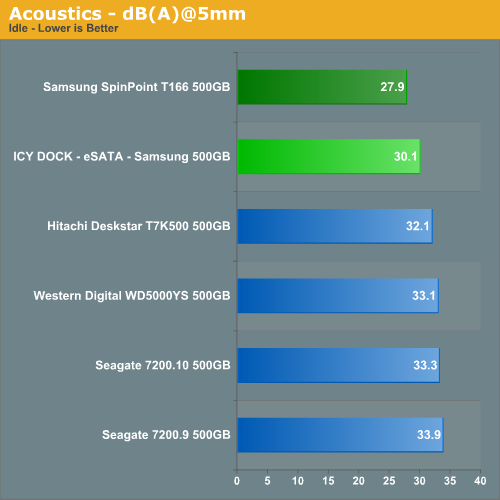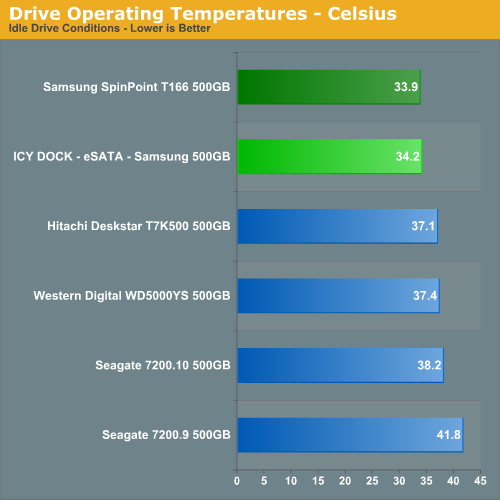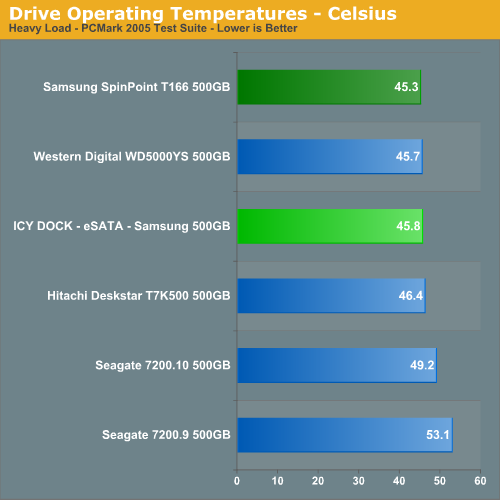ICY DOCK MB559US-1SMB: eSATA Enclosure with Pizzazz
by Gary Key and Dave Robinet on July 11, 2007 12:00 AM EST- Posted in
- Storage
Acoustics
Our acoustic test utilizes our standard test bed components but we implement Intel's power saving technology and turn off the case fans to isolate as much case noise as possible during testing. Our Corsair power supply is nearly silent in these tests and our MSI 8800GTX video card is water cooled by an external unit to provide a further decrease in our case's ambient noise levels. Our drives are attached to the drive cage with rubber bushings to assist in isolating the noise of the drive and avoid the resulting harmonic changes due to the case design.
Our acoustic tests are designed to measure the decibel levels while the system is at idle and also under load while running the General Hard Disk Drive Usage benchmark within PCMark 2005. We found through trial and error that this particular benchmark produces controlled readings across a wide range of applications within the benchmark. This particular benchmark utilizes 60% reads and 40% writes within the trace playback file.
The measurements are taken at a distance of 5mm from the rear and front of the drive being tested in order to minimize surrounding environmental noise. We have noticed that unless we run a completely silent system in a quiet room that measurements taken from 1m are generally not meaningful due to ambient noise levels. There are exceptions to this rule, but overall most modern desktop drives are quieter now than the other components in the system while under load.
The reported measurements are based on an A-weighted decibel score that measures frequencies similar to the way the human ear responds to sound. We take a total of three measurements for each test. We then subtract the high and low scores and arrive at our findings by reporting the remaining score.


Our Samsung SpinPoint T166 is already an extremely quiet drive at idle and it comes close to remaining that way in the ICY DOCK enclosure. However, since the Icy Dock is not equipped with an internal damping system or acoustic padding, it was naturally louder inside the enclosure. The external drive enclosure basically amplified any drive noise that was already present although subjectively it was difficult to discern any real differences.
Although our measurable test differences were substantial, it was quite difficult to pinpoint the differences in sound from a subjective viewpoint. Maybe all those years of hard rock have ruined our ears but in essence we found the sound emanating from the enclosure to be hollow at idle and heavy seeks having the same effect as your mother whispering loudly at you in church to wake up. It was a booming yet very soft noise that we noticed during the load tests that emphasized seek operations.
Our number one problem is the fact that our Samsung SpinPoint T166 500GB test drive likes to vibrate, in fact it would cause our test case to hum without rubber mounting grommets. The same held true for our Icy Dock enclosure, especially when mounted horizontally, but the vibration induced hum was greatly reduced with the unit in a vertical position. A small amount of vibration noise was still noticeable in this position but was less than than a bare drive mount in our test case. Our base dB(A) level in the room at the time of testing was 25 dB(A).
Thermals
Our thermal tests utilize sensor readings via the S.M.A.R.T. (Self-Monitoring, Analysis and Reporting Technology) capability of the drives and are reported by utilizing the Active SMART 2.42 utility. We also utilize thermal sensors and infrared measurement devices to verify our utility results. We test our drives in an enclosed case environment without the fans operational to simulate temperatures that could conceivably be reached in a near silent SFF or HTPC case design. We typically find the reported numbers drop anywhere from 18% to 25% on average with the case fans operational. Our base temperature level in the room at the time of testing was 25C.


Our Samsung drive basically remained at the same temperature as in our test case indicating that at least with this particular cool running drive that the case is not a hindrance to temperatures. In fact, the enclosure unit only consumes 2W of power at idle or under load which helps to contribute to the low thermal output increases we noticed during testing. We will have full results with additional drives like the WD Raptor and Hitachi 1TB drives in the roundup.
Our acoustic test utilizes our standard test bed components but we implement Intel's power saving technology and turn off the case fans to isolate as much case noise as possible during testing. Our Corsair power supply is nearly silent in these tests and our MSI 8800GTX video card is water cooled by an external unit to provide a further decrease in our case's ambient noise levels. Our drives are attached to the drive cage with rubber bushings to assist in isolating the noise of the drive and avoid the resulting harmonic changes due to the case design.
Our acoustic tests are designed to measure the decibel levels while the system is at idle and also under load while running the General Hard Disk Drive Usage benchmark within PCMark 2005. We found through trial and error that this particular benchmark produces controlled readings across a wide range of applications within the benchmark. This particular benchmark utilizes 60% reads and 40% writes within the trace playback file.
The measurements are taken at a distance of 5mm from the rear and front of the drive being tested in order to minimize surrounding environmental noise. We have noticed that unless we run a completely silent system in a quiet room that measurements taken from 1m are generally not meaningful due to ambient noise levels. There are exceptions to this rule, but overall most modern desktop drives are quieter now than the other components in the system while under load.
The reported measurements are based on an A-weighted decibel score that measures frequencies similar to the way the human ear responds to sound. We take a total of three measurements for each test. We then subtract the high and low scores and arrive at our findings by reporting the remaining score.


Our Samsung SpinPoint T166 is already an extremely quiet drive at idle and it comes close to remaining that way in the ICY DOCK enclosure. However, since the Icy Dock is not equipped with an internal damping system or acoustic padding, it was naturally louder inside the enclosure. The external drive enclosure basically amplified any drive noise that was already present although subjectively it was difficult to discern any real differences.
Although our measurable test differences were substantial, it was quite difficult to pinpoint the differences in sound from a subjective viewpoint. Maybe all those years of hard rock have ruined our ears but in essence we found the sound emanating from the enclosure to be hollow at idle and heavy seeks having the same effect as your mother whispering loudly at you in church to wake up. It was a booming yet very soft noise that we noticed during the load tests that emphasized seek operations.
Our number one problem is the fact that our Samsung SpinPoint T166 500GB test drive likes to vibrate, in fact it would cause our test case to hum without rubber mounting grommets. The same held true for our Icy Dock enclosure, especially when mounted horizontally, but the vibration induced hum was greatly reduced with the unit in a vertical position. A small amount of vibration noise was still noticeable in this position but was less than than a bare drive mount in our test case. Our base dB(A) level in the room at the time of testing was 25 dB(A).
Thermals
Our thermal tests utilize sensor readings via the S.M.A.R.T. (Self-Monitoring, Analysis and Reporting Technology) capability of the drives and are reported by utilizing the Active SMART 2.42 utility. We also utilize thermal sensors and infrared measurement devices to verify our utility results. We test our drives in an enclosed case environment without the fans operational to simulate temperatures that could conceivably be reached in a near silent SFF or HTPC case design. We typically find the reported numbers drop anywhere from 18% to 25% on average with the case fans operational. Our base temperature level in the room at the time of testing was 25C.


Our Samsung drive basically remained at the same temperature as in our test case indicating that at least with this particular cool running drive that the case is not a hindrance to temperatures. In fact, the enclosure unit only consumes 2W of power at idle or under load which helps to contribute to the low thermal output increases we noticed during testing. We will have full results with additional drives like the WD Raptor and Hitachi 1TB drives in the roundup.










13 Comments
View All Comments
Gary Key - Thursday, July 12, 2007 - link
We discovered an issue with the Intel Matrix Storage driver version 7.0.0.1020 and our ICY DOCK review unit that prevented true SATA 3Gb/s operation. An update to version 7.5.0.1017 did not work, even after an uninstall of the 7.0.0.1020 driver. However, after reinstalling Windows XP-SP2 and installing driver 7.5.0.1017, the unit performed as advertised. This was repeatable on our DFI P965 board with the ICH8R.We are still looking into why this occurred as it was not repeatable on our P35 board with the ICH9R nor the Intel BadAxe 2 board with the ICH7R. We will publish updated HDTach results shortly. There were not any differences in our actual benchmarks other than the normal variance between benchmark runs that is typically +/- .05%.
Stan11003 - Wednesday, July 11, 2007 - link
I think I could buy a 250GB drive for the cost of this enclosure....JarredWalton - Wednesday, July 11, 2007 - link
Which would work great as an internal-only HDD.